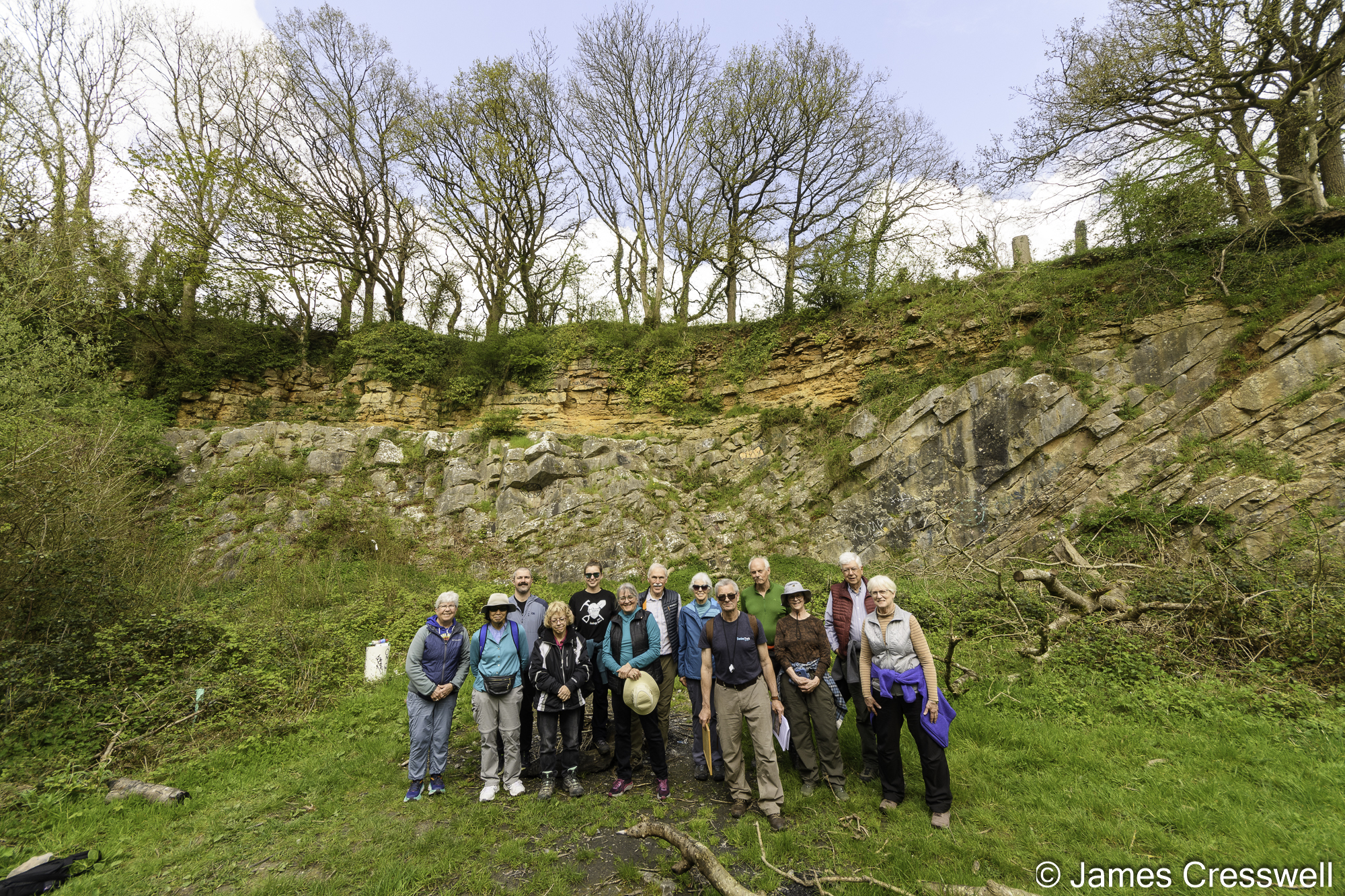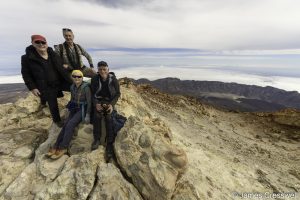In April 2023, we set off on our England & Wales trip, covering the Jurassic Coast, visiting the type areas of the Carboniferous, Devonian, Silurian, Ordovician and Cambrian periods, and seeing outcrops from every period in the geologic timescale – just as the tour name suggests! We welcomed guests from the USA, Canada and Australia and, once again, the tour was co-lead by James Cresswell and Dr Martin Whiteley.
The 2023 itinerary was slightly changed from previous iterations of the tour, with a brief foray to Dartmoor and into Cornwall. Many stops are detailed in our previous blog, which can be found here.
Route map of GeoWorld Travel’s 2023 ‘Jurassic Coast & the Complete Geologic Timescale’ tour
We have selected our favourite photos from the 2023 trip and these can be seen in the galleries below. If you would like to join us next year, the trip will be running from 15-26 April 2024 – further details can be found here: https://www.geoworldtravel.com/england-and-wales.php
Above from L-R: Stonehenge World Heritage Site. Archaeologists believe that Stonehenge was constructed from around 3000 BC to 2000 BC. The monument consists of an outer ring of vertical sarsen standing stones. These are locally derived Cretaceous silicified sandstones. Each around 13 feet (4.0 m) high, seven feet (2.1 m) wide, and weighing around 25 tons, topped by connecting horizontal lintel stones. Inside is a ring of smaller bluestones. These are Ordovician aged volcanic rocks derived from Pembrokeshire, in west Wales, 180 miles away. Inside these are free-standing trilithons, two bulkier vertical sarsens joined by one lintel. There is also a third type of stone, the altar stone that is made from Devonian aged Old Red Sandstone, originating from the Brecon Beacons in South Wales. The whole monument, now ruinous, is aligned towards the sunrise on the summer solstice. The stones are set within earthworks in the middle of the densest complex of Neolithic and Bronze Age monuments in England, including several hundred tumuli (burial mounds).
Steve Etches gives our group a guided tour of his museum: The Etches Collection, at Kimmeridge in the Jurassic Coast WHS.
A group photo with Steve Etches at the Etches Collection.
Above from L-R: Martin explains the stratigraphy on Kimmeridge Beach. The beach is the source of the Etches Collection fossils, and is the type area of the Jurassic Kimmeridgian stage of the Jurassic. The Kimmeridge Shales area the source rock of North Sea oil.
A loose rock from a recent rock fall that contains ammonites on Kimmeridge Beach
Durdle Door is a natural sea arch in Jurassic aged Portland limestone, in the Jurassic Coast WHS. The form of the coastline around Durdle Door is controlled by its geology – both by the contrasting hardness of the rocks, and by the local patterns of faults and folds.
Above from L-R: Martin explains the stratigraphy of the harder and softer layers in the Jurassic and Cretaceous rocks at Stair Hole, in the Jurassic Coast WHS.
The iconic Lulworth Cove, the classic example of differing amounts of erosion depending on the hardness of rock layers. The sea has broken through the harder Portland Limestone and eroded the softer Cretaceous sediments behind.
Above from L-R: Jarrod on the ammonite pavement on Lyme Regis’s Monmouth Beach, on the Jurassic Coast WHS.
Ichthyosaur rib bones protruding from a limestone boulder on Lyme Regis’s Monmouth Beach
Huge ammonites on Lyme Regis’s Monmouth Beach.
Above from L-R: The GeoWorld Travel group at the new Mary Anning statue in Lyme Regis which was unveiled in May 2022
The entrance to Church Cliff Beach in Lyme Regis – arguably the world’s most famous fossiling beach. It was here that Mary Anning made her iconic finds.
Above from L-R: Triassic aged red fluvial sedimentary rocks at Sidmouth Beach on the Jurassic Coast WHS
Hay Tor in Dartmoor National Park. The tor is made of Permian aged granite that was intruded as part of the Cornubian batholith in the late stages of the Variscan Orogeny.
Looking down from the summit of Hay Tor.
Above from L-R: Drakewalls Tin mine, part of the Cornish Tin Mining WHS
The group marvelling at spectacular chevron folds at Millook Haven, Cornwall. These folds in Carboniferous aged turbidites were formed in the Variscan Orogeny.
Spectacular chevron folds at Millook Haven, Cornwall. These folds in Carboniferous aged turbidites were formed in the Variscan Orogeny.
Above from L-R: The group looks for fossils in marine Devonian sedimentary rocks at Fremington Quay, Devon
Above from L-R: A replica of Cheddar Man in the position where the original fossil was found in Gough’s Cave, Cheddar, Somerset. The skeletal remains date to around the mid-to-late 9th millennium BC, corresponding to the Mesolithic period, and it appears that he died a violent death. A large crater-like lesion just above the skull’s right orbit suggests that he may have also been suffering from a bone infection. Excavated in 1903, Cheddar Man is Britain’s oldest near-complete human skeleton.
Cheddar Cheese maturing in Gough’s Cave, Cheddar.
Martin examines beautiful flow stones in Gough’s Cave, Cheddar. The caves have formed in Carboniferous limestone.
Above from L-R: The GeoWorld Travel group at the De La Beche Unconformity at Vallis Vale, Somerset. Here horizontal mid Jurassic aged yellow limestones lie on top of dipping grey Carboniferous limestones. The unconformity was described in the world’s first Geological Survey memoir in 1846.
Tour participants examine a reprint of William Smith’s 1815 geological map of Britain, at the site where he built the Somerset Coal Canal, and discovered stratigraphy.
Looking down on to the doubly inscribed World Heritage Sit of Bath. Both World Heritage Sites have strong geological links. The first, the Roman Baths, are Britain’s most important geothermal feature and the second, the Georgian architecture, is built from locally derived mid-Jurassic limestone.
Above from L-R: The GeoWorld Travel group at the Blaenavon Ironworks UNESCO World Heritage Site where steel was first produced from iron ore with a high phosphorous content. This a breakthrough that was overseen by James’s great-great-grandfather who was the General Manager of the Ironworks at the time.
Coal seams, ironstones and sandstones of the South Wales Middle Coal Measures Formation at Brynmawr
Bwa Maen, which means the Stone Bow, is a Variscan aged fold in Carboniferous limestone, in the Fforest Fawr UNESCO Global Geopark.
Above from L-R: Craig y Fro quarry. A fossilized lower Devonian river channel lies near the top of the Senni Formation of the Lower Old Red Sandstone. The site has yielded one of the best-preserved Devonian floral assemblages in Britain. The beds consist mainly of massive, lenticular, channelized green sandstones, with siltstone interbeds that are truncated by erosion surfaces at the base of the overlying sandstones, and are interpreted as the deposits of a high-energy, braided fluvial system.
The GeoWorld Travel group at Llanstephan Bridge; from this bridge Sir Roderick Murchison’s ‘First True Siluria’ can be seen. In 1831 Sir Roderick Impey Murchison undertook an extensive geological fieldwork tour of England and Wales. He recounted retrospectively that one of the most momentous aspects of the tour was his encounter with greywacke rocks at a place called Cavansham Ferry in the valley of the River Wye in Wales. It was here that Murchison first decided that there was sufficient evidence to enable him to make a systematic study of the greywacke rocks which was to culminate in the publication of ‘The Silurian System’ in 1839, and he came to regard the site as ‘The first true Siluria.’
Above from L-R: A fossil trilobite from the Upper Gilwern trilobite quarry. The trilobites were living on the flank of an Ordovician volcano.
Donna with a fossil trilobite she found at Upper Gilwern quarry.
The Craig Goch Dam in the Elan Valley was completed in 1904. The surrounding rocks are Llandovery (Silurian) in age.
Above from L-R: Cwmystwyth is a Scheduled Ancient Monument, with mining activity dating back to the Bronze Age. Silver, lead, and zinc mining peaked in the 18th century, and water was extensively used in the extraction process. The Banc Ty’nddôl sun-disc, the earliest gold artifact discovered in Wales, was found on the site in 2002.
A distant view of the Clogau gold mine in the Cambrian aged rocks of the Harlech Dome part of the ‘type’ Cambrian area. Cambria is the Latin name for Wales and gives its name to the Cambrian period. It is from this mine the gold for the British Royal Family is mined.
Above from L-R: Inside the Bronze Age copper mine at the Great Orme.
The Great Orme Bronze Age copper mine
The gift shop at Llanfairpwllgwyngyllgogerychwyrndrobwllllantysiliogogogoch railway station in the GeoMôn UNESCO Global Geopark.
Above from L-R: Dolbadarn Castle in ‘The Slate Landscape of Northeast Wales’ World Heritage Site and Eryri (Snowdonia) National Park. The slate is Cambrian in age and is situated in the ‘type’ Cambrian area.
The GeoWorld Travel group in front of England & Wales’ highest mountain Yr Wyddfa (Snowdon) (1085m). The mountain is made of Ordovician aged volcanic rock that has been sculpted by Ice Age glaciers.
A lorry crosses a bridge on the modern A5 road, which lies above a Roman bridge.
Above from L-R: Darwin’s Boulders on the shore of the beautiful Llyn Ogwen. These boulders are glacial erratics and once Charles Darwin had correctly identified them, he realized Britain must have been glaciated in the past and the idea of the Ice Age was born.
An Ordovician aged brachiopod at Gelli Grin near Bala.
A classic outcrop of Sedgwick’s Cambrian System, Gelli Grin; here he found fossils which were later shown to be Ordovician in age.
Above from L-R: Pistyll Rhaedr, the highest waterfall in Wales, flows over a hard band of Ordovician tuff onto softer Ordovician mudstones.
An unconformity in the Ercall quarry with Cambrian aged quartzite lying on an Ediacaran aged intrusion.
Ripples in Cambrian aged beach deposits in the Ercall quarry.
Above L-R: The iron bridge in the Ironbridge WHS, built in 1779; it was the world’s first metal bridge.
Martin explains an outcrop of Permian-aged sandstone at Bridgnorth formed by desert dunes on the super continent of Pangea.
Above L-R: Knowle Quarry on Wenlock Edge, the ‘type area’ of the Wenlock epoch of the Silurian. Here a bioherm reef can be seen below stratified layers.
Crinoid fossils from Wenlock Edge.
Above L-R: Ordovician Brachiopod fossils from Caer Caradoc, the ‘type area’ of the Caradoc. These fossils were originally thought to be Silurian in age by Murchison and are exactly the same age as Sedgwick’s ‘Cambrian’ fossils found at Gelli Grin near Bala. We know now they are Ordovician.
The GeoWorld Travel group finding fossils at Caer Caradoc with The Lawley and Murchison’s view in the background. The Lawley (the mountain in the top right) is made of pre-Cambrian igneous rock. Murchison’s view consists of Ordovician and Cambrian layers.
Lyth Hill, Shropshire is made of Cryogenian aged rocks, the oldest seen on the trip, it also offers the best views of the county’s geology.
Above L-R: Donna points to the famous Onny Valley unconformity in Shropshire. This subtle unconformity was completely missed by Murchison. It was discovered in 1854 and shows there was a considerable time gap between what was previously regarded as his upper and lower Silurian. Its discovery was one of the key pieces of evidence that led on to the founding of the Ordovician Period by Charles Lapworth in 1879.
The Shropshire woolly mammoth skeleton, found in 1988, on display in the Shropshire Hills Discovery Centre.
Above L-R: The view of Ludlow and its magnificent castle.
A trilobite found in the marine sediments, Ludlow aged sediments, immediately below the Ludlow Bone Bed.
The Ludlow Bone bed. This layer is packed with fossil fish bones and scales and marks the boundary between terrestrial Old Red Sandstone and marine Ludlow aged rocks below. For Roderick Murchison this marked the upper limit of his Silurian System and the Silurian/Devonian boundary, although we now recognise the lowest parts of the Old Red Sandstone to be within the Silurian, based on marine fossils from elsewhere in the world.



